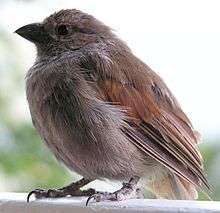Barbados bullfinch
| Barbados bullfinch | |
|---|---|
 | |
| A Barbados bullfinch | |
| Scientific classification | |
| Kingdom: | Animalia |
| Phylum: | Chordata |
| Class: | Aves |
| Order: | Passeriformes |
| Family: | Thraupidae |
| Genus: | Loxigilla |
| Species: | L. barbadensis |
| Binomial name | |
| Loxigilla barbadensis Cory, 1886 | |
The Barbados bullfinch (Loxigilla barbadensis) is a seedeater bird that is found only on the Caribbean island-nation of Barbados, where it is the only endemic bird species.
Taxonomy
The Barbados bullfinch was previously considered a subspecies of the Lesser Antillean bullfinch (Loxigilla noctis), which is found on neighboring islands.[2] Despite the misleading nature of its name, the Barbados bullfinch is not a bullfinch at all but a seedeater. The bird is known locally as a Sparrow.
Description
The Barbados bullfinch is a small bird, 14–15 cm (5.5–6 in). The upperparts are a dark olive-grey, the wings are mostly brown, underparts are greyish, while the under tail-coverts are tawny. The species is not sexually dimorphic, with females and males having similar plumage. The birds' calls include simple twittering, an occasional harsh petulant note, and a sharp trill.
Distribution and habitat
The Barbados bullfinch is found only on the island of Barbados. The birds' habitat includes shrubbery and forest undergrowth; the species has adapted well to humans, often being found in close proximity to areas of human habitation, such as gardens.
Reproduction
Barbados bullfinches construct a globular nest, with a side entrance, in a tree or shrub. The species lays two to three spotted eggs.
Gallery
References
- ↑ BirdLife International (2012). "Loxigilla barbadensis". IUCN Red List of Threatened Species. Version 2013.2. International Union for Conservation of Nature. Retrieved 26 November 2013.
- ↑ Birdlife International, What's new (2007), archived from the original on 28 August 2007, retrieved 2007-09-05
- "Barbados Bullfinch (Loxigilla barbadensis) - BirdLife species factsheet". birdlife.org. 2012. Retrieved 26 January 2012.
External links
![]() Media related to Loxigilla barbadensis at Wikimedia Commons
Media related to Loxigilla barbadensis at Wikimedia Commons



